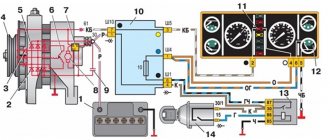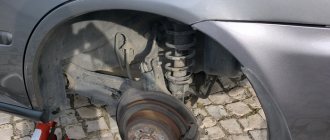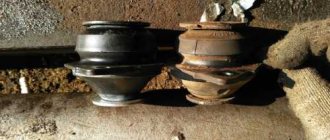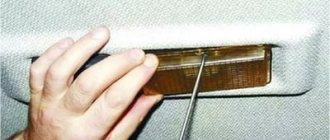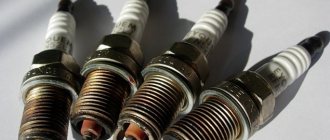It is not always possible to tell by the nature of the vibration where exactly the problem lies. On different cars, only the steering column can vibrate, putting it in the driver’s hands, but the entire body can shake. It all depends on the design, nature and degree of damage to the components and assemblies that need to be replaced. Let's look at the main causes of vibration during overclocking.
We study wheels and chassis - the main cause of vibrations
The main indicator that the wheels or drives of these same wheels are to blame for your problems is shaking at a certain speed. Often these are body vibrations in the range of 80-100 kilometers per hour, but sometimes the shaking may not go away even after 60 km/h, so in any case you need to fully diagnose the chassis.
In this case, it is not necessary to go to a service station and carry out expensive diagnostic operations. It is enough to apply all your knowledge and study each chassis unit for possible breakdown. The most common problems in this case are the following:
- the wheel mounts are unscrewed, which causes vibration on one of the wheels;
- The brake disc is poorly fixed; at speed it begins to vibrate;
- the wheel drive shaft is bent - the body vibrates constantly, with increasing speed the vibration intensifies;
- damaged CV joints - this is the most common problem that causes vibrations on the body;
- The wheel bearings are damaged, which causes shaking at any speed.
The most common problem in this manifestation is CV joints. To check their serviceability, just grab the shaft with your hand and try to turn it. If the shaft has play of more than a couple of millimeters, the CV joint must be replaced. Interestingly, vibrations of the car body during acceleration can be caused by both external and internal CV joints.
You can also easily determine if there is a problem with this chassis mechanism by examining the anthers. If the rubber part of the boot ruptures, we can safely talk about problems with this mechanism. If water, dust and dirt get into the CV joint, the unit will not survive more than a few days.
Two types of vibration
photo: Thomas Wonderka/flickr.com
They can be divided into steering wheel vibration and vibration of the entire car.
If vibrations touch the front of the chassis, they are most often sensed and partially suppressed by the steering. see also
The main reasons for a car to shake when braking
However, if the vibrations are intense enough or come from the rear axle, they are already transmitted to the entire body and, possibly, to the steering. It is not always the case that one type of vibration has the same cause as another, but often the causes are common.
Wheel alignment and tire quality are another reason for shaking
If the wheel alignment angle is incorrect, vibration, the car pulling to the side, uneven eating of rubber and other unpleasant manifestations are possible. In different models, these problems manifest themselves in different aspects. Adjusting the wheel alignment angles is one of the first processes that needs to be performed after detecting such a nuisance as body vibration.
Problems can also be caused by tires that are worn incorrectly, or a disc after a serious impact. The main processes that can be taken to eliminate body vibration in this case are as follows:
- adjusting the wheel alignment angle at a wheel alignment station;
- replacing tires if there are visual indicators of uneven or excessive wear;
- replacing or repairing a disc that shows dents and uneven rims;
- performing wheel balancing - often during operation the balancing weights fly off.
If the balancing weights have come off the wheel, this may well cause vibrations at speeds of 80 kilometers per hour. The problem is that it is simply impossible to determine this yourself and find out which wheel needs to be sent for balancing. Therefore, you will have to go to a tire shop and have all the wheels of your car balanced.
This is one of the most inexpensive and safest options for breakdowns due to vibration of the body or steering wheel during acceleration. Therefore, the first thing you need to do is check for the presence of such faults, and then transfer suspicions to other options.
How to eliminate car vibrations. And why are they dangerous for the car?
Are you familiar with the situation when your car begins to vibrate noticeably after installing new rims? Or when the same problem occurs when installing used tires? Avto.pro explained the dangers of body vibrations and how you can eliminate them yourself.
Why are vibrations dangerous?
Mild body vibrations are normal. They are almost completely eliminated by special elements of the car, such as rubber-metal products, a flywheel, etc. These parts wear out
and cease to perform their functions. But when the vibrations become so strong that the driver clearly feels them not only when driving, but also at idle, then you should start sounding the alarm. Vibrations can cause:
- Rapid wear of individual parts, such as elements of the chassis and steering mechanism;
- Rapid wear of car tires;
- Reduced ride comfort;
- Difficulty in making sharp turns and braking maneuvers.
Although all components of the car are adapted for operation in difficult conditions - shocks, temperature changes, exposure to ultraviolet radiation - fairly strong vibrations seriously affect their service life. Many experts believe that vibrations are the main “killers” of the chassis. It should be mentioned that strong body shaking negatively affects the driver and his passengers. They become irritated, less attentive, and get tired faster.
The driver may get used to body vibrations and think that this is normal. What if the shaking becomes strong, objects on the dashboard begin to move from side to side, and the picture in the rearview mirror begins to twitch? This is serious
cause for concern. Next, we will try to classify body vibrations and highlight the main reasons for their occurrence, and also outline options for solving problems.
What are the vibrations?
Perceptible vehicle vibrations usually occur when driving at high speed. However, in some cases, drivers encounter a problem even at idle speed right after starting the engine or when increasing the speed before moving off. Let's look at these points in more detail.
Vibrations at idle
. Vibrations of the gear shift lever, whistling and metallic knocking are noted. In the first case, it is possible for the internal combustion engine to trip and misfire; in the second case, you need to check the internal combustion engine airbags, and in the third, check the wear of the alternator belt. Shaking occurs when the clutch malfunctions, misfires and problems with the air supply.
Vibrations when increasing speed in place
. It is necessary to eliminate misfires, check the power unit control system and the air supply system. In rare cases, mild vibrations can be transmitted to the body of a car with a faulty clutch. It is recommended to check the release bearings and basket.
Vibrations
at speeds up to 40 km/h
. To begin with, it is worth checking the CV joint (the cause of crunching when cornering), the elements of the steering mechanism - the rack in the first place - and the clutch components.
At speeds of 40-60 km/h
. Vibrations at such speeds can be caused by the driveshaft (the shaft itself, the spider, the suspension bearings), the support bearings of the struts and unbalanced wheels. It is also recommended to check the exhaust system.
At speeds of 60-80 km/h
. It is recommended to check all the components specified in the previous paragraph, as well as the brake system. In the case of brakes, a fault will be indicated by another sound. At moderate speeds, severely worn tires will affect the performance of the vehicle. Vibrations often cause breakdowns of individual car components, which then aggravate the problem.
At speeds of 80-100 km/h
. Almost all of the above. The same applies to vibrations at speeds of 100-120 km/h and above. We also recommend checking the turbine if the car is equipped with one. Particular attention will have to be paid to the suspension elements. In particular, at high speeds, ball joints and worn-out cushions (supports) of units make themselves felt. On rear-wheel drive cars, you will have to check the cardan unit: shaft, crosspiece, bearings.
Tire wear
Body vibrations are often caused by severe wear of car tires. Sometimes the tire life indicated by the manufacturer and car enthusiasts themselves may be incorrect. The more severe the operating conditions and the worse the roads, the more often you will have to change your tires. Light vibrations can be transmitted to the body when driving on studded tires
- This is fine. It’s worse if they appear when switching to any new (read: not hardened) tires. Often the reason lies not so much in tire wear, but in the wheels themselves. Try to rearrange them and go out onto the road.
Important point
: The pressure in all tires must be optimal. If at least one tire has air pressure below normal, vibrations may occur. We will pay special attention to worn tires because they are easy to check. Vibrations can be transmitted to the car body if the tires:
- Has hernias (well-visible bulges);
- Heavily dirty - a layer of dirt, snow, etc. has stuck to it;
- Tires show uneven and severe wear.
It is important for a car enthusiast to be able to read the tread pattern and sidewall. As a rule, tires should be checked before each trip and cleaned of dirt. The vibrations will become stronger and more noticeable the higher the speed of the car. They usually become noticeable at speeds above 50 km/h. The steering wheel will begin to vibrate first.
Problem wheels
One of the most common causes of body vibrations is unbalanced wheels. Or rather, incorrectly selected or installed rims. Drivers often choose wheels without paying due attention to the diameter of the center hole
. If it is larger than the diameter of the hub, then problems may arise with wheel balancing. The driver may encounter the following problems:
- The appearance of radial and/or transverse runouts;
- Increased tire noise;
- Body twitching when accelerating;
- Uneven tire wear;
- Reduced vehicle maneuverability.
Strict adherence to the diameter of the central hole when choosing new rims is not necessary, but it is desirable. If it was not possible to comply with it, then the installation of such a wheel will be complicated. Since the wheel is centered by fastening elements, you can come to the conclusion that no auxiliary elements or accessories are required during its installation. In the material devoted to wheel spacers, we spoke in more detail about the need to use the so-called. arch supports
. We only note (and this is mentioned in the material) that some rims do not need spacers. However, we do not recommend tempting fate and immediately purchasing a set of plastic spacers for a set of disks.
Check the parameters of the installed rims. If you find a discrepancy between the diameters of the central holes and the hubs, then go to the nearest store and buy 4 plastic spacers. They can also be ordered online. Rearrange the wheels using spacers according to tutorials that are easy to find online. Or contact a service center where specialists will take care of this. It is highly likely that this procedure will solve the problem of wheel vibrations.
, which are transmitted to the body when driving.
If you suspect deformed rims or even problematic tires, get out on the highway and accelerate to 100-120 km/h. If the wheels are unbalanced due to their deformation, vibrations will become clearly noticeable. Inspect both the rims and tires. In case of purchasing used. components, such checks must be especially careful. It is not worth operating a car with problem wheels and tires.
Engine malfunction
Not the most common cause of strong body vibrations is problems with the engine. In this material, we uncovered the problem of internal combustion engine vibrations at idle speed.
. Normally, the power unit operates quietly and gently and does not affect ride comfort. The opposite situations arise when the following components wear out:
- Fuel injectors. We are talking not only about the complete failure of one or more injectors, but also about their contamination. Cleaning the injectors or replacing them eliminates vibrations;
- Worn spark plugs. Replacing spark plugs allows you to normalize engine operation;
- Air filter dirty. A normal filter almost does not interfere with air suction. But if it creates a lot of resistance to the flow of intake air, the engine will begin to vibrate more;
- Worn engine mount. If the supports (pillows) wear out, vibrations from the power unit will be transferred to the body.
A normally running engine will vibrate in any case, but if this affects ride comfort, then the driver should first check the supports and, if necessary, replace the main consumables. Separately, it is worth causing vibrations in an unbalanced engine. The problem here is more serious. The driver will have to contact specialists. You will need to align the shafts, replace the pistons, etc. – expensive diagnostics and repairs.
Problematic brakes
If unsuitable discs and worn tires cause constant vibrations, then if there are problems with the brakes, vibrations occur sporadically. Namely, when you press the brake pedal. The mechanism itself requires regular maintenance and replacement of individual components if they are severely worn out. Vibrations are transmitted to the steering wheel
. They can be either barely noticeable or clearly noticeable. Here's what you should pay attention to:
- Brake disc and pad;
- Hub;
- Caliper.
In rare cases, vibrations are caused by a stuck caliper. The caliper itself can be serviced - there are special repair kits and lubricants for this. Pads can be called one of the automotive consumables. They need to be changed when worn. Some pads are hard and over time they “eat away” the brake disc. This is evidenced by the appearance of concentric grooves. The disc may become deformed due to strong temperature changes
and/or become rusty. The worse its condition, the higher the likelihood of vibrations during braking.
Discs with a thin layer of rust, dirt and brake pad marks can be cleaned with a brush. Don't let the latter scare you too much - under extreme heat, some of the friction material of the pad may be imprinted on the surface of the brake disc. However, this also indicates that you installed pads on your car more for a quiet ride than for a sporty one.
Once again, the driver will have to check the wheels. The runout of the brake disc with resulting vibrations that are transmitted to the steering mechanism can be caused by improperly mounted wheels. In this case, it is also worth checking the hub. A deformed hub will have to be replaced. And if you start checking the hubs, then at the same time work on the brake calipers.
Malfunction of electrical appliances
Although it may seem to the reader that electrical appliances and car components cannot become a source of vibration, in practice the situation is exactly the opposite.
. The same cooling fan and air conditioning fan can vibrate at the same time, which will be felt by the driver. Particular attention should be paid to:
- Air conditioning system;
- Engine cooling radiator fan;
- Generator and starter;
- Wiper motors.
The strongest vibrations are caused by the cooling system fan. It’s worth getting to it and cleaning the impeller - this should remove the imbalance and the electrical appliance will start working quietly. The same goes for the air conditioning and heating systems. They should be turned on separately and determined when vibrations occur. The electric motor bearings will need to be cleaned and optionally replaced. The latter is also true for wipers. It is a good idea to check the attachment belts.
General recommendations
As can be understood from all of the above, vibrations of the car body can occur in a variety of cases. Sometimes they do not even indicate a breakdown of any component - you just need to carry out balancing
and calmly continue driving. Many car enthusiasts eliminate vibrations on their own. Should you contact a car service if you are worried that you will not be able to make repairs yourself? We propose the following algorithm of actions:
- Determine the nature of vibrations - how strong they are, where their source may be;
- Decide when vibrations appear - at what speeds, only when braking, etc.;
- Inspect the main components of the car (in particular wheels, tires) and, optionally, use a car scanner (if you have one) and decipher errors.
Next, you can revisit this material, ask friends for advice, and read blogs of drivers who have encountered a similar problem. As practice has shown, most often the cause of vibrations lies in the wheels
– the wheels themselves, the tires, or both. Experts will help you solve the problem. If the vibrations are caused by malfunctions of the chassis (CV joints, hubs) and transmission (universal drive, outboard bearings), then you will have to assess the complexity of the repair yourself. For example, you can replace the universal joint and suspension bearings in a garage. But it is better to delegate serious work with the gearbox and engine to specialists.
Conclusion
Drivers should not ignore the problem of vibrations of the entire body or individual elements of the car. They lead to rapid wear of entire components, which over time will result in expensive repairs. Add to this the reduction in safety and driving comfort, as well as the negative impact on the physical and mental health of the driver and his passengers.
Often the problem is solved by replacing the tires and reinstalling the rims using spacers. Otherwise they are called instep supports and centering rings. But if the vibrations are associated with malfunctions of suspension parts, cardan or engine mounts, then the driver will have to buy spare parts and install them himself or contact specialists. All this is worth the money spent.
If you find an error, please select a piece of text and press Ctrl+Enter .
Share
Engine mounts, tie rods and other problems
There is another group of problems that cause vibrations when accelerating a car. It is difficult to collect these problems into one bundle, because they are all different and arise for various reasons. Vibration often occurs when one of the engine mounts is broken. This can easily be checked by increasing the speed while shaking.
The gearbox may also be the culprit for this type of problem. If the car starts to shake at 80 kilometers per hour, you can very easily check the fault of the gearbox by performing the following procedures:
- accelerate to a speed of about 85 kilometers per hour;
- depress the clutch and observe the vibration change;
- engage third gear and smoothly release the clutch;
- try accelerating from 50-55 kilometers per hour in last gear.
If the nature of the shaking does not change in all these experiments, the box has nothing to do with this problem. If there is more shaking when the gearbox is engaged, you will have to check whether it is involved in this problem.
You can also check the automatic transmission. At a speed of about 85-90 kilometers per hour, it is enough to switch the gearbox selector to modes 3, 2, D, N and observe the operation of the box itself and the change in vibrations. Often the gearbox is not to blame for the vibration of the car body, but there are such cases.
The car shakes when accelerating
Vibration or shaking when accelerating a car can cause the most unpleasant sensations of discomfort in a car. The worst thing is when you count on rapid acceleration of the car (for example, to overtake a car), but when you press the gas pedal, you get in response, uneven acceleration with jerks.
In order to find out why the car shakes during acceleration, you need to check the following:
— Low oil level in the gearbox . Yes, a low level of transmission fluid can cause vibration and dips in the acceleration dynamics of the car when accelerating. Including, as a rule, when the oil level in the transmission is insufficient, jerks are observed during acceleration.
— The gearbox filter is clogged . A dirty automatic transmission filter can lead to vibration when accelerating the car. Replace the filter element with a new one yourself or at a car repair shop.
— Wear of the cardan joint . The U-joint on your driveshaft may wear out, causing it to shake or vibrate when you drive or pull away. This is especially obvious when accelerating a car. If the cause of the vibration is really the cardan joint, then do not delay replacing the part, because in the event of a complete breakdown, your car will not be able to move, which threatens with unnecessary expenses for evacuating the car to a car service center.
There can be a huge number of possible problems with a car, and a specific breakdown does not always give specific signs of its presence. Drivers often complain about body shaking when accelerating or at a certain speed. There can be quite a lot of problems that determine this indicator. If your car has vibration during acceleration, you should look at all possible breakdowns and immediately replace the failed components.
Let's sum it up
If you are unable to find the problem that is causing the body or steering wheel to vibrate in your car when accelerating, you should contact a professional. Do not leave this problem, because it can worsen and create dangerous travel conditions for the driver and passengers of the car. It is necessary to respond as quickly as possible to all possible problems and eliminate them by replacing failed machine elements.
Often, to determine the problem, you don’t even have to go to a service station and use expensive diagnostics. It is enough to inspect the car yourself and determine what problems caused the body vibrations.
Source:www.avto-flot.ru
Categories of products that may be of interest to you based on the article “There is vibration during acceleration: the main causes of the problem”:
Vibration in the car
It can drive any driver crazy if the car shakes. But fortunately, in 75 percent of cases, the cause of the car shaking can be eliminated, which will allow the car to return to its former comfort. Each of us wants our car to run smoothly and without vibration. We especially want the car not to disappoint us and to be as before (like new). But, unfortunately, sooner or later any car begins to break down due to natural wear and tear. But this doesn't mean it's time to buy a new car. After all, uneven car performance can occur not only on a fairly used car.
If your car is shaking from an incomprehensible vibration, then the main thing is not to panic. If the car is older than 3-5 years, then most likely some components of the car have exhausted their service life. As they say, the car began to show its age. If you don’t want to overpay for car diagnostics to identify the cause of the shaking, then you can try to identify the problem yourself.
Spare parts, maintenance
Products from the Dustershop77 range that may be of interest to you:
| Name | Manufacturer | Price | Availability | Add to cart |
| BR-001-GARD-URDP | Mud flaps enlarged (widened) Duster-GARD front | Duster-Guard | 1500 / 1200 rub. Discount: 1000 rub. | >10 |
| DC495 | Discount card (Dusterclubs.ru, Dustershop77.ru) | 700 / 500 rub. Discount: 500 rub. | >10 | |
| DC218 | Air deflector “Warm feet” for Duster, Logan, Sandero, Largus | 900 / 350 rub. Discount: 250 rub. | >10 | |
| DC654 | Frill with fastening without 3M tape (Duster/Terrano) (ArtForm) | ArtForm (Yuago) | 3000 / 2000 rub. Discount: 1600 rub. | >10 |
| PT014-RDU112901 | Trunk sill trim PTGroup | Pt GROUP | 1200 / 1000 rub. Discount: 900 rub. | >10 |
| 005-008502 | Trunk sill protection | Russian Artel | 1400 / 1100 rub. Discount: 1000 rub. | >10 |
| DG-006-GARD-RDSHCH | Front diffusers - aerodynamic flaps Renault Duster (set of 2 pieces) | Duster-Guard | 700 / 600 rub. Discount: 500 rub. | >10 |
| DC1024-V117 | Windshield and roof edge seal | Duster-Guard | 700 / 500 rub. Discount: 300 rub. | >10 |
| R12711 | Wind deflectors (window deflectors) COBRA/Autoplex | COBRA/Autoplex | 2000 / 1600 rub. Discount: 1500 rub. | >10 |
| NRD-009102 | Frill under the windshield (RA) | Russian Artel | 2500 / 2100 rub. Discount: 1800 rub. | 5 |
Faulty tires
Getting into the tire occurs due to careless driving, defects or poor quality of the road. It is impossible to determine the appearance of a meningeal hernia visually. A jumping steering wheel at speeds of 50-80 km/h may alert you to a problem; higher speeds cause the body to vibrate. Tires with a hernia cannot be repaired; the tire must be replaced.
Uneven air pressure in all tires. Inflated tires can withstand even the smallest road irregularities. Ensure uniform tire pressure in accordance with technical documentation.
Uneven tire wear can be another cause of body vibration at speed. Wear can be recognized visually. The solution is to reposition the worn tire to ensure even wear. For example, right rear tire to left rear tire.
Vibration in the body and deformed rims
Often the cause of unpleasant vibrations is disc deformation. This is easily determined on balancing stands. Most often, deformations occur due to driving through potholes. The problem occurs in the spring, when their numbers increase.
If it is not possible to go to the stand, then you can try to find the dent visually. Most severely, the disc jams from the inside. Stamped steel wheels are more likely to deform than their cast counterparts.
In addition to dents, vibration at speeds of 100-120 km/h can also be caused by simply a curved disk. At the same time, the wheel can rotate smoothly on the stand. This is because it is attached to the device through the central hole. On a car, the wheel is not centered when installed. Warped discs also come from the factory.
Symptoms of imbalance and diagnosis
You can determine if the balance is out of balance when driving at high speeds. In this case, vibration will be felt on the steering wheel or on the body. The problem can be diagnosed using a visual inspection. Wheel rims should be as smooth as possible, without dents. If the car has not recently driven at speed through potholes, and slight vibration is felt on the steering wheel and body, then most likely the problem is imbalanced balancing.
However, you should not think that if the steering wheel shakes, then it is enough to give only two front discs for balancing. Often the only way to fix a problem is to balance all four.
Why does the steering wheel shake at speed?
If we have rejected the first possible reason, then we will move on to the second. It is important to understand that if the steering wheel shakes at speed, then the problem is somewhere in the front of the car. Perhaps you recently had a long trip or maybe you were braking for a long time and then got into a puddle. My point is that perhaps your brake discs have worn out and they are no longer in the same shape as they were originally. That is, an imbalance appears here too, but not as a wheel, but as a ligament of the hub, disk and wheel as one whole. The reason is unlikely, but it does exist and this also needs to be checked and ruled out.
Also, according to statistics from service centers, one of the likely reasons may be play in one of the wheels parallel to the ground. If there is such a possibility, then lift the car on a lift and check this version and also rule it out. Among all the possible reasons, there could be anything, so to make sure of this for sure, you will need to use the services of specialists, because this is your safety.
Any driver is very alarmed by situations when vibration appears at a speed of 100-120 km/h on the steering wheel or along the body. And the point here is not only about discomfort, although it must be said that these symptoms are a rather unpleasant phenomenon. If measures are not taken to correct the problem in time, this may lead to a violation of the geometry of the body. This will not happen immediately, but slowly and gradually.
Distortions can provoke a violation of the aerodynamic characteristics, as well as deterioration of the vehicle's handling. In addition, due to vibration effects, cracks can form in the metal, which is not only dangerous in itself, but also requires expensive repairs.
And that's not the whole problem. If the car vibrates at a speed of 100-120 (VAZ 2110 is no exception), this leads to the loosening of various fasteners. This phenomenon can lead to serious consequences - accidents, as well as various malfunctions and damages, which will be very difficult to eliminate. It is worth adding that this kind of shaking is a signal of breakdowns that will yet occur in the near future.
Vibration at speeds of 100-120 km/h occurs for various reasons. These may be completely harmless problems. But sometimes there are serious cases that require global intervention in the technical structure of the car. Further in the article we will look at the typical reasons why vibration is transmitted to the steering wheel at high speeds.
Worn or warped brake discs
These elements are installed on the hub and are clamped by pads when the speed decreases. There is practically no gap between the disc and pads. Therefore, the surface of the assembly must be perfectly flat. The slightest distortion of the disc causes the steering wheel to vibrate at speeds of 90-100 km/h. Warping of brake elements most often occurs due to frequent and intense braking, as well as when driving through deep puddles. The heated disk bends due to sudden cooling. This element cannot be repaired - only replaced.
Worn suspension
Heavily worn chassis components can cause vibration in the steering wheel. Suspension affects the vehicle's contact with the road. If there is play in the chassis, then this is the cause of the imbalance during rotation. But suspension play is only a “catalyst” for wheel vibration. It in itself cannot serve as the main reason for steering wheel vibration.
Speed 100-120 (VAZ—
2108 is no exception) can demonstrate it to you when the car has a steering gear malfunction. It is necessary to eliminate these breakdowns first. It may be dangerous. However, problems should be diagnosed last, if all other components are in perfect order.
At idle
Frequent causes of engine vibration at idle speed are associated with improper operation of power unit components, and less commonly, with breakdowns of transmission parts. Shaking at idle is felt immediately after starting the car and when stopping. The causes of body shake can be:
An engine mount is a rubber-metal or hydraulic gasket between the engine and the body parts of the car. The main purpose of the pillow is to soften vibrations and detonation from a running engine, which transmits vibration to the body.
Most often, the engine is mounted on four or five supports; the breakdown of one of them causes the body to vibrate abnormally.
In 90% of cases, support failure occurs due to a break in the rubber part of the metal support. The average service life of an engine mount is 100,000 km.
If your car's fuel system is faulty, shaking may become noticeable when the engine is idling, at high speed, or accelerating. There are interruptions in the fuel supply, which is manifested by a sharp decrease in speed or a sharp increase.
When diagnosing, it is necessary not only to check the filters, but also to test the injectors. The operation of the injectors is checked on a special stand using hydraulic equipment.
Car shaking at idle occurs when the electrical wiring in the car is faulty. The engine is shaking, creating a slight vibration in the body. This indicates a fault in the spark plug, a possible crack.
When braking
Body vibration during braking can occur due to wear of the brake system components, wheel imbalance, or due to poor, “bald” tires. The causes of vehicle vibration may be associated with breakdown or wear of the following parts of the brake system:
If at idle the engine runs smoothly, acceleration and driving proceed without noticeable shaking, but when braking the car “throws” - you need to check the bolt pattern of the wheel rims and the tightening of all screws.
Standard diagnostics, which are recommended to be done once a year, help prevent body shakes from occurring. But if a problem appears, you will have to check all the components of the car, even if the reason is a loose bolt.
Source





